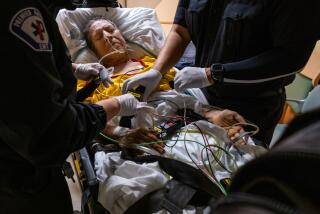COLUMN ONE : Hospitals Can Make You Sick : Infections acquired by patients are the direct or indirect cause of 80,000 U.S. fatalities a year. In many cases, simple hand-washing would prevent illness.
There is a story that Dr. William Schaffner likes to tell his students about the problem of hospital-acquired infections. In the annals of medical detective work, it might be called âThe Case of the Streptococci and the Anesthesiologistâs Backside.â
There had been a mysterious outbreak of postoperative wound infections at Schaffnerâs hospital. It was particularly baffling because the offending germs were strep--common denizens of human throats, not usually known to make their way into wounds elsewhere in the body.
Schaffner was called in to investigate. He quizzed operating room personnel. He took countless cultures from innumerable throats. Nothing turned up. But he did find that most of the wound-infection cases had a common element--the same anesthesiologist.
That the anesthesiologist might be the culprit seemed inconceivable. He had stood at the head of each patient, some distance from the wounds. His throat was clean. But Schaffner asked him to take oral antibiotics, just in case.
Months passed. The pattern continued.
So Schaffner set about learning every obscure fact about strep. In very rare cases, he discovered, they took up residence in the human anus. Schaffner called back the anesthesiologist and âcultured his behind.â Lo and behold, he found the bugs.
âIt turned out he was a fluke--an asymptomatic carrier of strep in his rectum,â said Schaffner, chairman of preventive medicine at Vanderbilt Medical Center in Nashville. The germs would shed from the anesthesiologistâs body when he walked. âJust by his moving around, he put strep into the air and they fell into the wounds.â
While the tale may be amusing to Schaffnerâs students, the outbreak was not. Many of the patients had to have their wounds reopened for treatment. One older woman, in the hospital because of a hip fracture, died from the infection--a fatality Schaffner to this day believes could have been avoided.
âThe reason Iâm in infection control is I wish I had been as smart in August as I was in December,â said Schaffner, now a national expert in the field. âIf Iâd been that smart then, I could have prevented her death. . . . I carry her with me in my memory as a motivator.â
Hospital-acquired infections are one of the leading causes of death in the United States, the direct or indirect cause of about 80,000 fatalities every year. As many as 6% of all people admitted to hospitals end up with infections that they would not otherwise get.
And, some researchers argue, the infection rate may be creeping up.
To some extent, such infections are a price of medical progress. More patients are getting the benefit of high-tech medicine; but every time a person receives a new organ, an immunosuppressive drug, even an intravenous catheter, he runs a risk of infection.
Whatâs more, hospitalized patients are at high risk in the first place. Many have serious illnesses and underlying conditions that predispose them to infection. Bedsores, obesity and poor circulation can raise a personâs risk. So some infections may be inevitable.
But as many as a third could be prevented, experts estimate, if health care workers strictly followed infection-control procedures--from the appropriate use of technology such as ventilators to something as prosaic as the scrupulous scrubbing of hands.
Hand-washing may be the single most important tool of infection prevention. It is also the one most frequently violated, experts say. Studies suggest that health care workers wash their hands less than half as often as they should. Doctors, some say, are the worst offenders.
So ways of improving compliance with hand-washing rules are being explored--from user-friendly soaps to stern reminders from patients. New hospitals have more sinks. Some hospitals keep canisters of disinfectant hand creams taped to doorknobs.
In one program, hospitals gave pediatrics patients stuffed teddy bears to encourage them to remind the staff to wash their hands. (While the reminder worked, researchers found that the bears quickly became colonized with bacteria and fungi.)
Even so, some critics say the issue deserves more attention. Research funding, they say, has been scarce. Consumer activists complain that regulatory oversight is insufficient and that patients have no access to hospitalsâ infection rates.
âPatients come into the hospitals to be made better and they actually, in many cases, are made worse,â said Dr. Robert W. Haley, director of the division of epidemiology at the University of Texas Southwestern Medical School in Dallas and a national expert in the field. âThat bothers a lot of physicians and nurses. Itâs against what weâre trying to do.â
In early 1985, officials at St. Josephâs Medical Center in Stockton noticed an upsurge in wound infections in patients recovering from open-heart surgery. The germ was Staphylococcus aureus, common on the skin and the mucous membranes of the nose and mouth.
In the previous 11 months, there had not been a single such infection in the several hundred patients undergoing the procedure. But between December, 1984, and May, 1985, at least eight cases cropped up, according to a confidential state report on the incident.
Hospital officials began hunting for common denominators and quickly lit upon a particular type of the bacterium and a suspected carrier. Although the hospital declined recently to identify the carrier, the state report identifies him as a surgeon.
The germs turned out to be hiding in the surgeonâs nose. He was put on antibiotics, but the infection continued. Eventually, he went back on antibiotics and refrained from working until it was proven in repeated cultures that his infection had been wiped out.
âYou or I could be carriers,â Liz Mitchell, associate vice president for quality at St. Josephâs Health Care Corp., said in an interview. âBut weâre not dealing with people prone to infection. In different work, we could put people at risk.â
It is impossible to count the number of hospital-acquired, or nosocomial, infections. The average hospital surveillance program is believed to pick up only about half. But about 2 million such infections are estimated to occur every year.
About 10% of infected patients die in the hospital of one cause or another, studies suggest. Of those who die, one in 10 succumb to the infection itself. In another three, the infection is a contributing factor. In the other six, the infection plays no significant role.
The price of those infections can be measured in health-care dollars as well as lives. They are believed to cost hospitals between $4 billion and $4.5 billion a year--a figure that includes the price of extended hospitalization, additional drugs and procedures.
In a study by Haley, infected patients ended up spending, on average, an extra day to an extra week in the hospital. That adds up to more than 8 million unnecessary patient days a year. Haley found that the most serious surgical wound infections added 68 days.
Researchers disagree on whether the infection rate is rising. Some say it has remained stable, even while high-tech medicine has increased the risks. But others say the rate rose by 10% in the 1970s and may be even higher than the commonly cited figure of 5% to 6%.
It is clear, however, that patients are picking up more troublesome infections, such as germs that have grown resistant to common antibiotics. Federal health officials have investigated nine outbreaks of hospital-acquired tuberculosis in the past three years.
Most of those outbreaks involved multidrug-resistant tuberculosis in patients whose immune systems had been damaged by the human immunodeficiency virus, which causes AIDS. But Dr. William R. Jarvis of the U.S. Centers for Disease Control said that others are in danger, too.
âWhen that HIV-infected person walks out of the hospital with multidrug-resistant TB and starts coughing . . . the fact is, itâs not just that the HIV-infected person is at risk,â said Jarvis, chief of investigations in the hospital-infections program. âItâs all of us.â
A hospital-acquired infection is defined as one that occurs during or after hospitalization and was not incubating at the time of admission. As Haley has put it, they come in as many varieties as there are microorganisms, medical technologies and sites in the body.
Urinary tract infections are the most common, followed by surgical-wound infections, pneumonia and infections of the bloodstream. Other types include meningitis, skin infections and various viral infections, including hepatitis and flu.
Germs have been spread in hospitals by everything from electronic thermometers to air conditioners and devices used to measure the specific gravity of urine. At UCLA Medical Center, a sleepwalking child once exposed others to chickenpox, said Dr. James D. Cherry.
âItâs a difficult problem because itâs no single problem,â said Dr. John P. Burke, an infectious-disease specialist and president of the Society for Hospital Epidemiology of America. âItâs a composite of hundreds of problems.â
Paradoxically, one of the main causes is advanced medical technology. Although new procedures and drugs have vastly improved many patientsâ prospects for survival, they have also left many patients more vulnerable to infection than in the past.
Cancer chemotherapy lowers a patientâs natural defenses. Organ-transplant patients receive drugs to suppress their immune systems. Invasive techniques, such as surgery and catheterization, by their nature, bypass the bodyâs primary protection, the skin.
The problem has been further complicated by the widespread use of antibiotics: Some infectious organisms have grown resistant to standard treatments. As a result, some hospitals harbor bugs that have become unusually difficult and expensive to treat.
âEven if everyone behaves meticulously and appropriately every single time, we are still going to have infections acquired in hospitals,â Schaffner said. âSo the challenge for us is to keep the level of infections to the lowest possible.â
How low that might be is a subject of debate. Many estimate that the rate could be brought down by one-third--a figure based on Haleyâs finding that hospitals with careful monitoring and staff feedback managed to reduce their infection rates by that amount.
In most hospitals, that monitoring falls to an infection-control committee--a prerequisite for licensing and accreditation. The committees tend to be made up of nurses, physicians and members of the administration and support services.
Many larger hospitals have also developed surveillance programs to keep statistics on infection rates for comparison with those of other hospitals. By the mid 1990s, standardized surveillance programs will be mandatory for all hospitals seeking accreditation.
There are also federal guidelines--from technical suggestions on when to change intravenous and urinary catheters to more general rules governing the circumstances under which health care workers should wash their hands.
Those circumstances include: before all invasive procedures, before caring for anyone with a weakened immune system, before and after touching wounds, after caring for an infected patient and after contact with mucous membranes, blood, body fluids or excretions.
Hand-washing is âone of only 10 or 12 practices proven to be effectiveâ in reducing the risk of infection, said Elaine Larson, a professor of nursing at Johns Hopkins University School of Nursing. âIronically, itâs the cheapest and the least followed.â
âThings like sterilization of surgical instruments are always followed,â she said. âClosed drainage for urinary catheters, thatâs done 100% of the time. Hand-washing is up there (in importance) with those . . . (but) people lose sight of its importance.â
The reasons given for neglecting hand-washing are numerous. In some situations, health care workers do not believe that there is a risk. In other cases, it is inconvenient, the soap causes skin problems and, most frequently, time is short.
As Haley explained it, a hospital is a complex and hectic environment, compared by some to âa space capsule with people dying around you.â Amid the machinery, haste and life-and-death pressures, it can be difficult to get the job done and avoid infection.
âYears ago, we talked about re-education,â said Gina Pugliese, director of infection control for the American Hospital Assn. âBut you canât always get people to change their behavior. Now the big push is to get safe devices in the workplace.â
Yet some critics want infection control to get more attention. They fear that hospital cost-containment efforts are taking resources from infection control. They also say that the AIDS epidemic has shifted the focus from patientsâ to health care workersâ risks.
In some cases, patientsâ and health-care workersâ interests are one and the same. But in other instances they are not. While the increasing use of latex gloves may protect staffers, some researchers say they may create a false sense of security that the patient is fully protected.
Some experts trace what they say is the relative neglect of the issue of hospital-acquired infections to the lack of a system for counting them in the nationâs vital statistics. In medical records, an infection-caused death is often attributed to the patientâs underlying disease.
Perhaps as a result, researchers believe that the subject has received insufficient attention in federal research circles. Dr. Donald Goldmann of Childrenâs Hospital in Boston said: âI donât think this problem has caught the imagination of people who fund research.â
Consumer activists also claim that hospitals are not held sufficiently accountable for infections. They say one reason is that an aggrieved patient must prove that his infection was avoidable and that the hospital was negligent--a task lawyers say is difficult.
Charles Inlander, president of the Peopleâs Medical Society, a medical consumer group, suggests that consumers should have access to hospitalâs infection rates. Patients should also insist that no health-care workers touch them without first washing their hands.
Larson, the professor of nursing, suggests a simple reminder: âI didnât see you wash your hands.â She added: âMy sense is that if a physician or nurse hears that one time in their career from a patient, their behavior will be permanently affected.â






